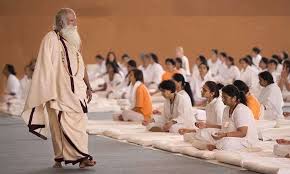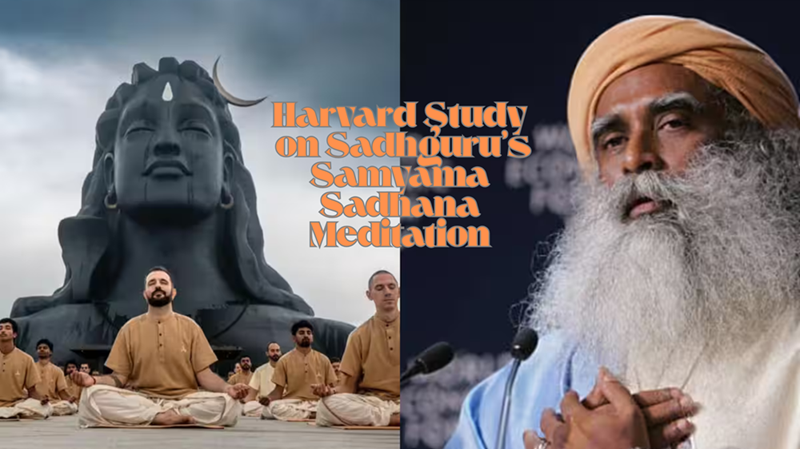In the quest for longevity and mental well-being, meditation has long been touted as a powerful tool. Now, a groundbreaking study backed by Harvard University has brought global attention to an ancient Indian meditation technique—Sadhguru’s Samyama Sadhana Meditation. According to the research, this intensive meditative practice may actually slow down brain aging, offering hope for millions seeking to preserve cognitive health as they age.
But what is Samyama Sadhana? What did the Harvard-backed study on Samyama Sadhana meditation uncover? And what does this mean for the future of brain health and meditation? Let’s dive deep into the science, the practice, and the transformative potential of Samyama Sadhana meditation.

What is Samyama Sadhana Meditation?
Samyama Sadhana Meditation is an advanced meditation program designed by Sadhguru, the founder of the Isha Foundation. Rooted in classical yogic science, Samyama is an intensive 8-day residential meditation retreat that combines powerful yogic practices, guided meditations, and periods of silence. The word “Samyama” in Sanskrit refers to the simultaneous practice of concentration (dharana), meditation (dhyana), and complete absorption (samadhi).
Key Features of Samyama Sadhana Meditation
- Duration: 8 days of silence and meditation
- Prerequisites: Completion of several preparatory programs (Inner Engineering, Bhava Spandana, Shoonya Intensive)
- Practices: Includes Hatha Yoga, Pranayama (breathwork), and various guided meditations
- Environment: Conducted in a controlled, supportive environment at the Isha Yoga Center in Coimbatore, India
Participants often report profound experiences, including increased mental clarity, emotional balance, and a deep sense of inner peace.
The Harvard-Backed Study on Samyama Sadhana Meditation: An Overview
A team of researchers from Harvard Medical School, Beth Israel Deaconess Medical Center, and the Isha Institute of Inner Sciences collaborated to investigate the effects of Samyama Sadhana Meditation on brain health. Their findings, published in peer-reviewed journals and highlighted by the Times of India, have made headlines worldwide.
Study Objectives
- To assess whether intensive meditation can slow the biological markers of brain aging
- To measure changes in cognitive function, brain connectivity, and neuroplasticity among participants
Why Is This Study Important?
Brain aging is a natural process that can lead to cognitive decline, memory loss, and increased risk of neurodegenerative diseases like Alzheimer’s. Discovering non-pharmaceutical interventions that can slow or reverse brain aging is a major focus of contemporary neuroscience.
How Was the Study Conducted?
Study Design
- Participants: Over 400 individuals from 30 countries, aged between 22 and 65
- Duration: 8-day Samyama Sadhana Meditation retreat, with pre- and post-assessments
- Assessment Tools: Neuropsychological tests, MRI scans, blood biomarkers, and psychological questionnaires
Samyama Sadhana Meditation : Key Methodologies
- Cognitive Testing: Memory, attention span, and executive function were evaluated.
- Brain Imaging: MRI scans measured changes in brain connectivity and structure.
- Biological Markers: Blood samples were analyzed for markers of aging and inflammation.
- Psychological Well-being: Participants reported changes in mood, stress, and overall well-being.
Control Group
A control group of non-meditators was used for comparison to ensure the observed effects were specific to the Samyama Sadhana experience.
Samyama Sadhana Meditation : Key Findings – Meditation and Brain Aging
The Harvard-backed study yielded several significant findings:
1. Slowed Brain Aging
- Biological Age Reduction: Participants showed a remarkable reduction in their biological brain age, as measured by specific biomarkers.
- Improved Neuroplasticity: Increased connectivity in brain regions associated with attention, memory, and emotional regulation.
2. Enhanced Cognitive Function
- Better Memory and Focus: Participants demonstrated improved performance in memory and attention tasks.
- Faster Information Processing: Enhanced ability to process and recall information.
3. Reduced Stress and Inflammation
- Lower Cortisol Levels: Meditation led to a significant decrease in the stress hormone cortisol.
- Reduced Inflammatory Markers: Blood tests showed lower levels of inflammation, which is linked to slower aging and better brain health.
4. Long-Lasting Benefits
- Sustained Improvements: Follow-up assessments indicated that many of the benefits persisted for months after the retreat.
Understanding Brain Aging
Before exploring why these findings matter, let’s briefly review what brain aging entails.
What Happens as the Brain Ages?
- Neuron Loss: Gradual reduction in the number of neurons
- Decreased Neuroplasticity: Lower ability to form new neural connections
- Cognitive Decline: Memory, attention, and processing speed often decrease
- Increased Risk: Higher susceptibility to neurodegenerative diseases
Why Is Slowing Brain Aging Important?
Slowing or reversing these changes can help maintain independence, improve quality of life, and reduce the risk of age-related diseases.
The Science Behind Meditation and Neuroplasticity
How Does Meditation Affect the Brain?
Research over the past two decades has shown that meditation can:
- Increase gray matter density in areas linked to memory and learning
- Enhance connectivity between different brain regions
- Reduce activity in the default mode network (DMN), associated with mind-wandering and aging
What’s Unique About Samyama Sadhana Meditation?
While many meditation techniques offer benefits, Samyama Sadhana’s combination of intensity, duration, and yogic practices appears to amplify these effects. The Harvard-backed study is among the first to document such profound changes in a large, diverse group of participants.
What Makes Samyama Sadhana Meditation Unique?
1. Depth and Intensity
Unlike typical mindfulness or relaxation techniques, Samyama Sadhana requires participants to undergo weeks of preparation and then immerse themselves in 8 days of silence and meditation.
2. Holistic Approach
The program integrates:
- Physical Yoga: Enhances body-mind connection
- Breathwork: Regulates the nervous system
- Guided Meditations: Deepens mental focus and awareness
- Dietary Guidelines: Supports physical and mental detoxification
3. Supportive Environment
Conducted in a serene, natural setting, participants are free from distractions, allowing for deep internal exploration.
The Role of Sadhguru and Isha Foundation
Who is Sadhguru?
Sadhguru Jaggi Vasudev is a globally renowned yogi, mystic, and visionary. He founded the Isha Foundation, a non-profit organization dedicated to human well-being through yoga, meditation, and social outreach.
Isha Foundation’s Contributions
- Research: Collaborates with leading universities on yoga and meditation research
- Outreach: Offers programs in over 150 cities worldwide
- Sustainability: Initiatives like Rally for Rivers and Cauvery Calling
Sadhguru’s approach combines ancient wisdom with modern science, making practices like Samyama Sadhana accessible and relevant in today’s world.

Potential Implications for Mental Health
1. Preventing Cognitive Decline
If meditation can slow brain aging, it may help prevent or delay conditions like Alzheimer’s and dementia.
2. Managing Stress and Anxiety
Lower cortisol and inflammation levels suggest meditation can be a powerful tool for managing chronic stress and anxiety, both of which accelerate brain aging.
3. Improved Quality of Life
Enhanced cognitive function and emotional regulation can lead to better relationships, productivity, and overall life satisfaction.
How to Practice Samyama Sadhana
Prerequisites
Samyama Sadhana is not a beginner’s program. Participants must complete:
- Inner Engineering: Foundational course in yoga and meditation
- Bhava Spandana: Deepening of inner experience
- Shoonya Intensive: Advanced meditation techniques
The Retreat Experience
- Location: Isha Yoga Center, Coimbatore, India (and select international centers)
- Duration: 8 days of silence, meditation, and yoga
- Daily Schedule: Includes multiple meditation sessions, yoga practices, and periods of mindful silence
At-Home Practice
While the full Samyama Sadhana requires in-person participation, elements of the practice—such as daily meditation, breathwork, and yoga—can be incorporated into home routines for ongoing benefits.
Expert Opinions and Testimonials
What Do Scientists Say?
Dr. Rudolph Tanzi, a leading neuroscientist at Harvard, commented:
“The findings suggest that intensive meditation programs like Samyama Sadhana may offer a non-pharmacological way to slow brain aging and enhance cognitive resilience.”
Dr. Balachundhar Subramaniam , MD, MPH, FASA

Participant Experiences
Many participants report:
- Profound inner peace
- Enhanced clarity and focus
- Lasting improvements in mood and well-being
Global Recognition
The study has drawn attention from neuroscientists, psychologists, and wellness experts worldwide, prompting further research into the mind-body connection.
Frequently Asked Questions
Q1: Can anyone participate in Samyama Sadhana?
No. Due to its intensity, only those who have completed the required preparatory programs can attend.
Q2: Are the benefits of Samyama Sadhana scientifically proven?
Yes. The Harvard-backed study provides strong evidence of its positive effects on brain aging and cognitive function.
Q3: How long do the benefits last?
Follow-up studies indicate that many benefits persist for months, especially when participants continue daily meditation and yoga practices.
Q4: Is Samyama Sadhana safe?
For healthy adults who meet the prerequisites, it is considered safe. However, those with certain medical or psychological conditions should consult a healthcare professional before participating.
Q5: Can similar benefits be achieved with other meditation techniques?
While many meditation forms offer cognitive and emotional benefits, the unique structure and intensity of Samyama Sadhana may produce more pronounced effects.
Conclusion: A New Era for Mind-Body Wellness
The Harvard-backed study on Sadhguru’s Samyama Sadhana meditation marks a significant milestone in the integration of ancient wisdom and modern science. By demonstrating that intensive meditation can slow brain aging, the research offers hope for millions seeking to preserve cognitive health, manage stress, and enhance overall well-being.
As the world grapples with rising rates of cognitive decline and mental health challenges, practices like Samyama Sadhana provide a beacon of hope—a reminder that the keys to longevity and vitality may lie within.
Get more Spirituallity & Wellness Updates on Popnewsblend.

Hi, I’m Prashant Jain — a curious soul, storyteller, and content creator at heart.I’ve always been drawn to the world of entertainment, travel, sports, health & lifestyle — not just as a writer, but as someone who genuinely lives these experiences. Whether I’m binge-watching the latest OTT series, exploring offbeat spiritual destinations in India, or diving deep into wellness routines and cricket match insights, I love sharing what I discover with like-minded readers.
PopNewsBlend is my way of blending personal journeys with meaningful stories — ones that inform, inspire, and keep you ahead of the curve. Everything I write comes from real observations, hands-on experiences, and a deep passion for understanding the world around us.
Discover more from Popnewsblend
Subscribe to get the latest posts sent to your email.







